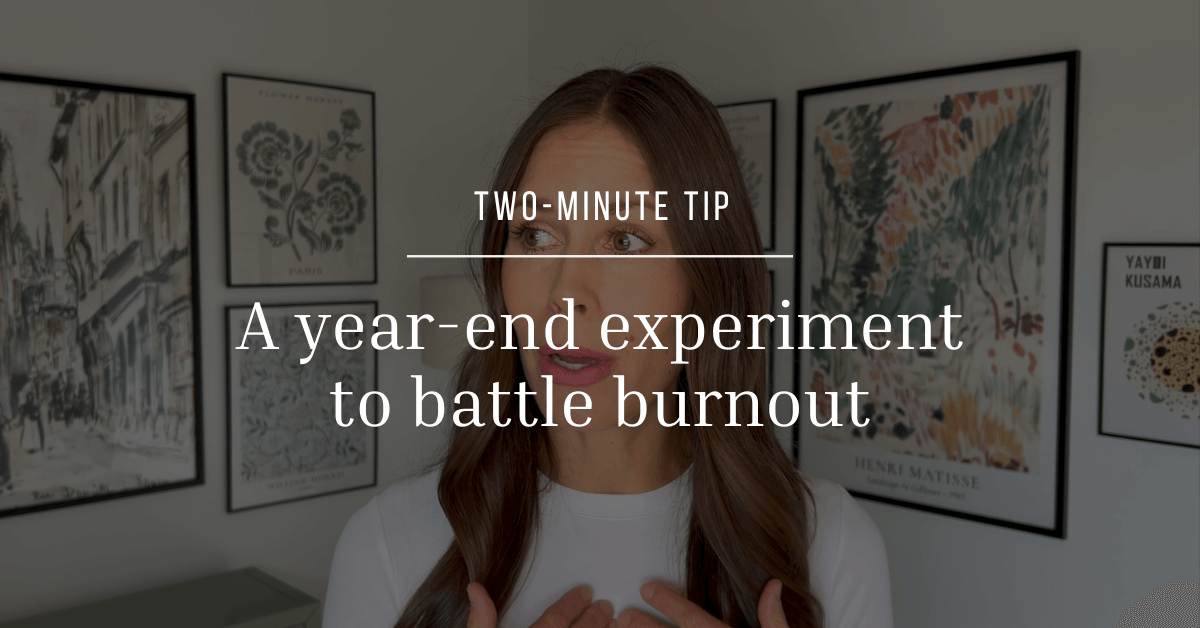A year-end experiment to battle burnout
We're stepping into the final month of the year. How are you feeling about work? Still energized, or barely crawling to the 2023 finish line?
If the research holds true (and I believe it does), chances are you're not as energized by work as you'd like to be. Studies indicate that burnout levels have reached unprecedented highs in recent years.
It's time to do something about it. Stop waiting for your work rhythms to change. Instead, take control of changing them.
In this week's Two-Minute Tip video below, I share a tactic I've increasingly incorporated over the years to battle burnout. The tactic is using Parkinson’s Law to my advantage.
Originally formulated by Cyril Parkinson in 1955, Parkinson’s law is the theory that work expands to fill the space available to it. For example, if you have a habit of tackling two extra hours of work every night, your workload will continue to expand to fill those extra two hours.
Maybe you want to pull back on work, but you’re afraid it will come with performance costs. I’ve been there too…many times.
I can recall several pivotal moments when I decided to conscientiously restructure my work hours. Every time, I was terrified that the work would be unmanageable and performance would suffer. But each time, I became more productive, improved my prioritization skills, and maintained my standards of excellence.
Here are a few of my most notable pivots…
2012: One year into motherhood, I felt like I was drowning. I was mildly depressed and struggling to enjoy this new season of life. I wanted to continue to do meaningful work—and do it well—but also desperately wanted more time with my baby. I negotiated an almost unheard of shift in my corporate schedule at the time, switching to a four-day (32-hour) workweek. I am incredibly grateful for the leaders above me who were willing to navigate the red tape and give this experiment a chance! Having three full days to be a mom each week brought me back to life, and also brought joy back in my work again. The result: I led my team to design and successfully launch a massive enterprise-wide program the next year. It was, hands-down, the biggest mark I left on the talent development landscape during my time at Boeing.
2020: I took my evenings back and stopped working at night (you can learn more about this shift in this video and this blog post).
2021: I stopped using before and after school daycare and started scheduling meetings during school hours only. This enabled me to stop the early morning chaos in our home, personally send my girls off to school, and be ready to help them process the day when they got home. Kudos to COVID for forcing this shift!
2023: I experimented with a shorter work week during the summer months to capture more summer break memories with my family.
Now, you may be thinking, “Sure, sounds great for you, Abbey. But I’m not my own boss and can’t just change my schedule like that.” To this, I’d respond:
My changes started before I became my own boss, while working in a very conservative Fortune 50 “old school” corporate culture. The best part? The changes I negotiated ended up becoming more available to other employees thereafter.
Your shifts may not look the same as mine, but don’t underestimate the power of minor shifts.
I’d bet there is more opportunity than you realize. Don’t be afraid to propose some big ideas to your leadership; and propose them as experiments rather than long-term changes. A trial test-run will feel much more appetizing than a permanent shift.
Please, take advantage of this last month of December to initiate a positive pivot in your schedule—a shift that will battle burnout and reignite joy and energy in your work (and life). It’s time for change. And you’re responsible for making it happen.
-
Well, I recently had the opportunity to deliver a keynote on the topic of burnout at a law conference, a legal conference. As you can imagine, many attorneys struggle with burnout, but guess what? They are not the only ones. It has become quite the common experience across a broad range of professions today.
In fact, over the last few years, the Google searches for the term "signs of burnout" have increased by over 200%. Maybe you searched for it thinking, ah, I might be experiencing burnout right now.
Well, one thing that we can do to intentionally battle against burnout is to set much more firm boundaries for ourselves.
Have you heard of the term Parkinson's law? It is this notion that our work expands to, or shrinks to the amount of time that we allow for it. So if I decide to allow a 12-hour workday, then my tasks are going to expand to that 12 hours that day. If instead I decide I'm working a seven-hour workday today, my tasks will magically shrink to that amount of time.
Now, it's not magic, but we definitely get more focused and we become more efficient when we set those firm boundaries for ourselves. It can't be completely unreasonable, but within reason, setting those boundaries will end up helping so much.
I know from personal experience because over the past many years, gradually I have set more and more firm boundaries for myself, and every time I think there is no way this is going to work. And every time Parkinson's law does its trick and all of a sudden I realize, okay, I can block off that time. I can feel free from the work during that time.
And so if you are currently in burnout or approaching it, I want to encourage you to pick one firm boundary to set for yourself, and then try it for one or two weeks as an experiment and see how it goes.


